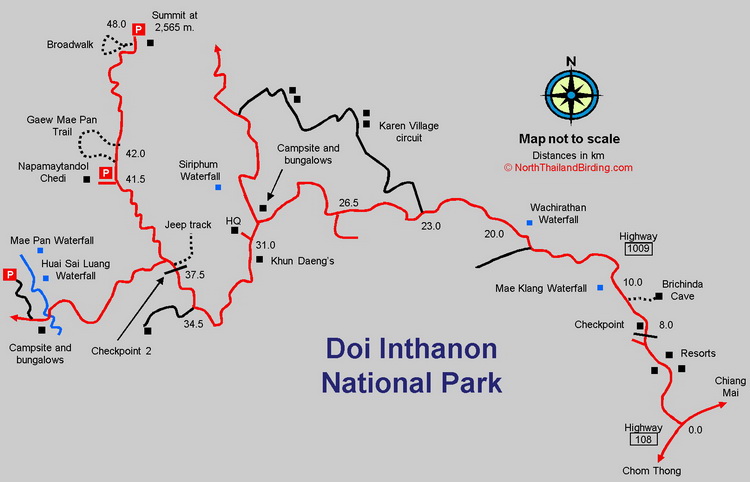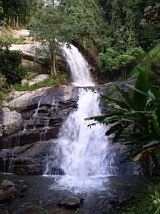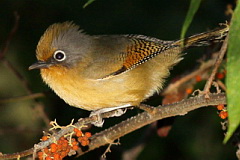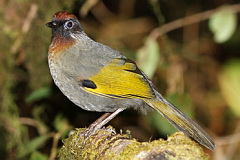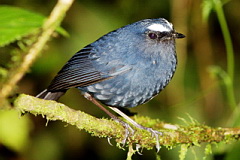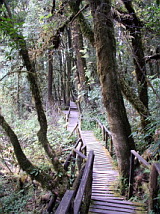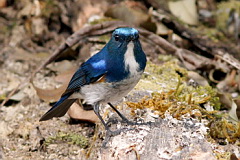Overview
For those short of time or wanting to see the largest variety of species within a small area in northern Thailand, Doi Inthanon should be the first choice. The 40 kilometre winding road within the park allows a large altitudinal range, with differing habitats, to be visited easily. With three to four days here in the cool season it is possible to see at least 120 species. The lower areas consist of scrub and dry open Dipterocarp forest, with mid and high elevations holding extensive rain forest. The summit of Doi Inthanon, at 2,565 metres the highest point in the country, has Rhododendron forest and a small Sphagnum bog. Information on this page verified/accurate as of 13 Jun 2025.
Access
As the crow flies, the park is less than 50 km southwest of Chiang Mai. By road, the 80 plus kilometres to the entrance takes around an hour and a half depending on traffic. From Chiang Mai head southwest from the city on Highway 108, the Chiang Mai to Hot road, through Hang Dong and just before the town of Chom Thong turn right onto Highway 1009. The park is well sign posted all the way from Chiang Mai. From the turning it is 8 kilometres to the entrance, where the usual entrance fee is charged. The park gate opens very early in order to be at the top for sunrise. Conveniently, road kilometre markers are found all the way to the summit at Km 47. This has resulted in the interesting birding areas being denoted largely by distances along the road.
Accommodation and Facilities
Within the park the usual national park bungalows and campsites can be found. These are centred in two areas; the first around the headquarters at Km 31, and the second around the river at Mae Pan on the western side. The former area is far more popular, due to easy access to food stalls and restaurant facilities. The area at Mae Pan has no facilities other than showers and tiolets. The Mae Pan area is the much quieter and better camping area. If camping during the cool, dry season, night temperatures can be decidedly cold.
Within the park, private accommodation is somewhat limited. A couple of guest houses have sprung up in the surrounding villages, which are signed along the road, and the small shop of Mr. Daeng has a few rooms of varying price. Recently, up-market accommodation is available in the King's Project just before Siriphum Waterfall.
Good accommodation facilities are found just outside the park along highway 1009, where a fair number of resorts and restaurants span a range of prices. Popular with birders and birding groups has been the Inthanon Highland Resort on the eastern side of the road. The adjacent Touch Star Resort and close by Little Home Inthanon Resort have also been used by visiting birders. The town of Chom Thong, only ten kilometres from the entrance also has several hotels, resorts and restaurants, as well as fuel and convenience stores.
The majority of food stalls and restaurant facilities are found around the park headquarters, although some fresh food and a lot of fruit is sold at the market stalls just after the headquarters and in the small adjacent town. At busy times a few vendors occasionally set up kiosks at various parking areas on the road to the summit, and at the summit itself is a small coffee shop that is almost always open.
Birding
Starting with sites from the entrance gate and working uphill.
Brichinda Cave Walk
Historically the start of the track to the cave was indicated on the right side of the road a short distance from the entrance. However, following the exact trail appears to be an exercise in futility as a maze of footpaths wind through the very open woodland here. It is easier to access the cave itself from outside the park. For birding the dry forest here, the easiest approach is to simply wander anywhere in this open dry forest, with or without a GPS, looking for interesting species. Few birders ever walk in this area, but it potentially holds any of the lower elevation dry woodland specialists such as Black-headed Woodpecker, Red-billed Blue Magpie and Rufous-winged Buzzard.
|
Mae Klang Waterfall A typical area of dry forest similar to much other along the lower reaches of the highway. Red-billed Blue Magpie occurs in the area, and a look at the falls may produce Black-backed Forktail. Kilometre 13 Just before the bridge at the Km 13 marker is a parking area on the right, next to a river. A bridge and concrete road cross the river and lead into the surrounding hills. The road is paved for about a kilometre and then turns into a graded track only easily passable by vehicle in the dry season. Scanning the river from the bridge itself sometimes reveals Black-backed Forktail. The main track, after crossing the river, heads steeply uphill and follows a ridge with views into a valley to the north, and can be followed for several kilometres to a village. |
This area holds Collared Falconet, Black-headed Woodpecker and Rufous-winged Buzzard. Also White-rumped Falcon can be found, although sightings are infrequent.
Wachirathan Waterfall
Being one the largest and more spectacular waterfalls in the park this one can have a large number of visitors, so best to be early. Take the steps down to the bottom of the falls, where the main species of interest to look for include Plumbeous Water Redstart, White-capped Redstart and Slaty-backed Forktail, with Blue Whistling Thrush regularly found.
Kilometre 26.5
A paved road leads off left here, initially into an area of rice paddies, and then via a dirt road through forest edge with wet gullies and continuing beyond through farmland and scrub. In winter the fields may hold interesting migrants, and forest edge can be checked for a variety of mid-elevation forest species. Habitat in this area is not the best, so if short of time press on to other better areas farther uphill.
Campsite at Kilometre 30
Just after the Km 30 marker turn right onto the road leading through a large Hmong village toward the intensively farmed orchards and hillsides beyond. A few hundred metres after turning, the park bungalows and main campsite, with checkpoint, are passed on the right. Turn into the area and continue about 200 metres, through the campsite to a small pond on the left. The pond and gully running into it are the favoured area of Black-tailed Crake, that is highly likely to be heard in the evening, but requires a fair degree of luck to see. Continuing through and beyond the campsite is a track passing damp forest edge and overgrown fields and ditches, also good for the crake, although here it's even harder to see. The orchards along the main road after the campsite area are the favoured wintering area for Daurian Redstart and Fire-capped Tit when they occur on Doi Inthanon.
Headquarters and Khun Daeng's at Kilometre 31
The park HQ around the 31 km marker is the main hub for food and accommodation. It is also one of the few areas within the park with a mobile phone signal. As most of the habitat in the area has been cleared, few birds of note occur. However, a visit for lunch or breakfast at Khun Daeng's small restaurant, at km 31.5 can often be rewarded with a bird or two. The left side of the restaurant overhangs a damp gully that regularly holds Dark-sided Thrushand other species attracted to scraps from the kitchen. Khun Daeng also has a birders' log book, many photographs of rarer species pinned to the wall, and is knowledgable of birds in the vicinity.
Track at Kilometre 34.5
This dirt road runs for a couple of kilometres through both open and closed forest, as well as through an area of pines toward the end, to what appears to be a fire/ranger station. Green Cochoa is sometimes found along here and any number of forest birds could potentially occur. Hume's Leaf Warbler is regular in the pines. Just before the ranger station is a barrier, which is usually open. At the barrier another wide track goes off, uphill, to the left. This can be followed for at least a couple of kilometres and passes much more open habitat where species can include Streak-breasted Woodpecker, Collared Falconet, Spectacled Barwing and Red-eyed Scimitar Babbler.
|
Jeep Track at Kilometre 37.5 Other than the summit boardwalk, this one kilometre trail is probably the most birdwatched area on Doi Inthanon. The track itself has long since ceased being used by vehicles but is well trodden by birders. Like many forests in Thailand a walk along this trail is often frustratingly devoid of birds. Slaty-bellied Tesia is fairly common here, as are Green Cochoa and leeches in the wet season. For those feeling adventurous, this track continues beyond the first kilometre, down into a valley, but has become a quite overgrown in places. The area around the start of the trail and Checkpoint 2 is frequented extensively by photographers. Spectacled Barwing can often be found along the road, with early morning being especially productive when the sun first hits the trees and warms the forest edge. However, the constant procession of vehicles on the road can rapidly becomes irritating. Mae Pan At Checkpoint 2 it is possible to turn left and head toward the mid elevation forests at Mae Pan. The road threads down through nice looking forest, although finding safe pull offs on the narrow road is difficult. At Mae Pan the river holds Plumbeous Water Redstart, White-capped Redstart and Slaty-backed Forktail. Those with time can explore the tracks and trails around this area that are interesting in winter and harbour Sulphur-breasted Warbler and Striated Yuhina. Napamaytandol Chedi at Kilometre 41.5 Just before the chedi are some excellent views over the lower regions of the park. The habitat around the chedi itself, for which an additional 30 Baht fee is charged, is open scrub. A large number of visitors come here to pay their respects, so arrive early. The scrub is good for sunbirds and occasionally Buff-throated Warbler and White-headed Bulbul and Mountain Bamboo Partridge is regualrly seen early morning in the area. Gaew Mae Pan Trail at Kilometre 42 Just after the chedi a large parking area marks the start of the looping Gaew Mae Pan Nature Trail - now written Kew Mae Pan. Habitat along this trail is highland evergreen forest with some open grassland. However, the introduction of a 200 Baht fee for a compulsory guide to walk this trail has killed off interest from birders and probably most visitors. It is however the only reliable spot in the park to look for Goral. Summit Area at Kilometre 48 The number of visitors at the summit can become overwhelming on a busy weekend, and this spot probably ranks as number one for running into other birders in Thailand. To have the best chances of seeing shy or rarer birds it's necessary to be here early or late, although early in the cool season will be decidedly cool with frost likely and little to no bird activity. The main focus should be the boardwalk around the Sphagnum marsh where regular species include Snowy-browed Flycatcher, Himalayan Bluetail, Dark-sided Thrush, Ashy-throated Warbler, Blyth's Leaf Warbler, Himalayan Shortwing and Pygmy Cupwing. Wintering Eyebrowed Thrush are occasionally joined by rarer thrush species. Ashy Wood Pigeon roosts in the area, so are often loitering well after sunrise. Crowds permitting, another short boardwalk behind the visiting/picnic area leads to the actual summit marker. |
Common species should include Silver-eared Laughingthrush, Dark-backed Sibia and Green-tailed Sunbird plus, occasionally, Rufous-throated Partridge. Buff-barred Warbler occurs in low vegetation along the road. The summit area is one of the few places in Thailand where Yellow-bellied Flowerpecker can be found.
Outside The Park
The immediate surroundings of the Inthanon Highland Resort, with scrub and small lake are well worth inspecting if staying or time permitting. A network of tracks and roads both here and behind the adjacent Touch Star Resort have some good species including Blossom-headed Parakeet and Purple-naped Spiderhunter. Some staff at the Inthanon Highland Resort are familiar with the birds of the area and can advise on species of interest. On some evenings and very early mornings, Blossom-headed Parakeet can be found in small numbers at the newly signed Blossom-headed Parakeet Conservation Area. To find this area turn left at the parakeet sign, about 250 metres before the Touch Star Resort. Follow this narrow road 250 metres and park in the small parking area where a visitor's log book can be found. From the car parking area walk left about 200 metre, along a narrow canal, to the end of the track where a poorly designed tower hide is found.
Checklist
Checklist of species.
Gallery
Additional images from Doi Inthanon available in the Thailand Travel gallery.
Sunrise and Sunset
Detailed sunrise and sunset times.

